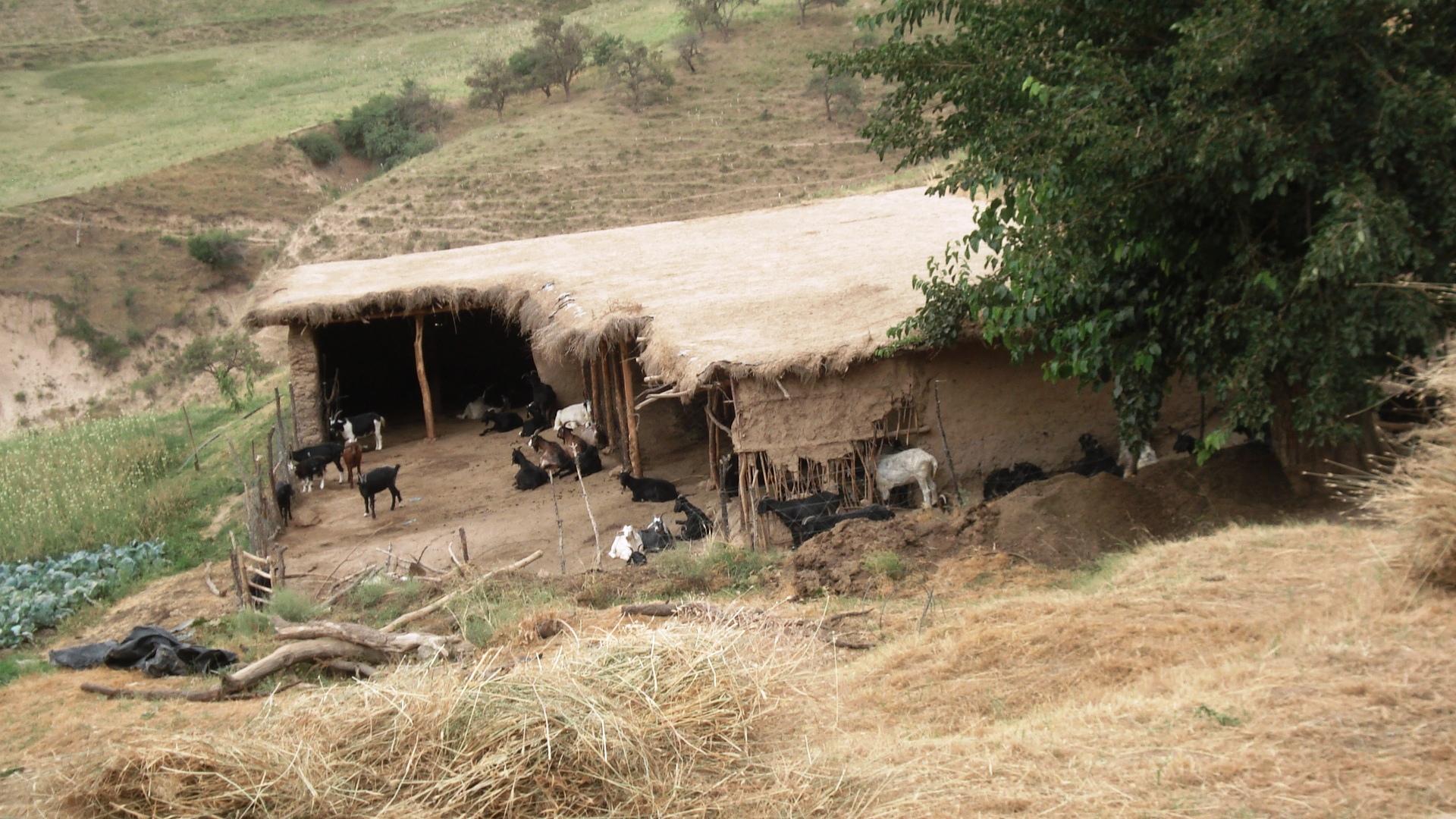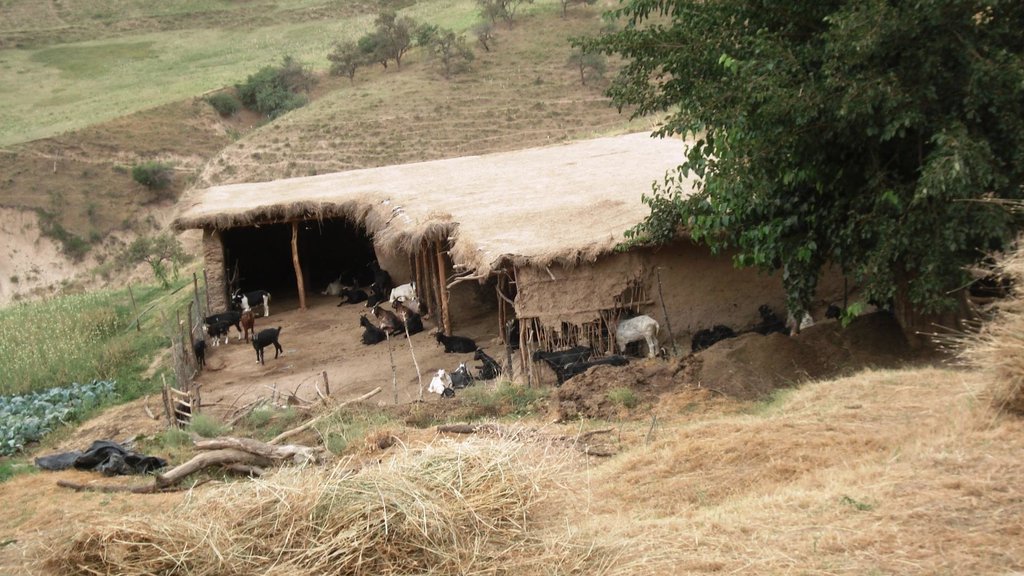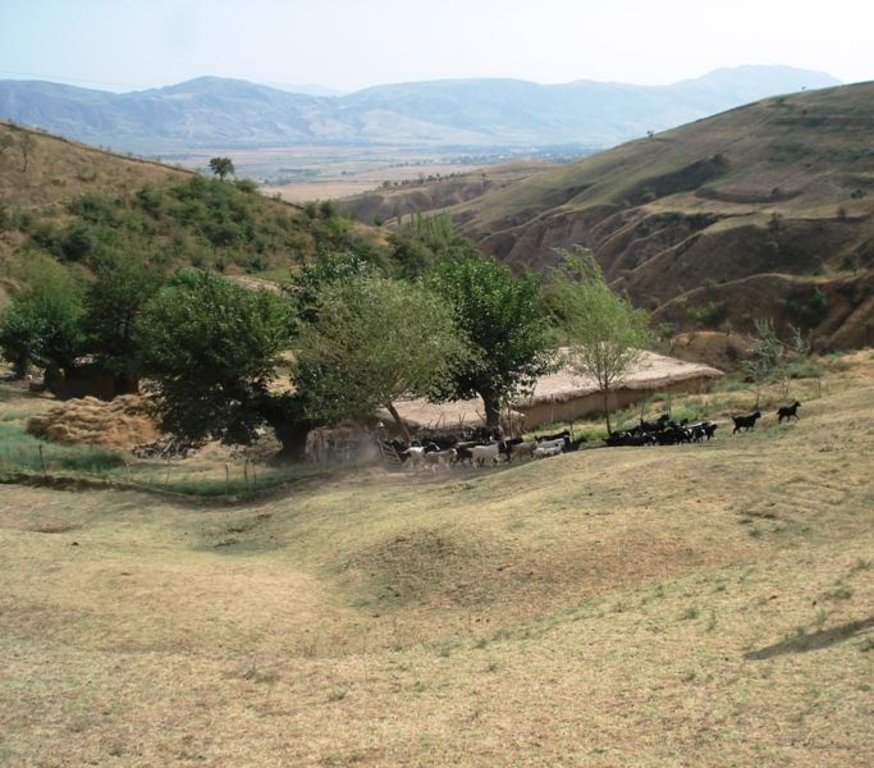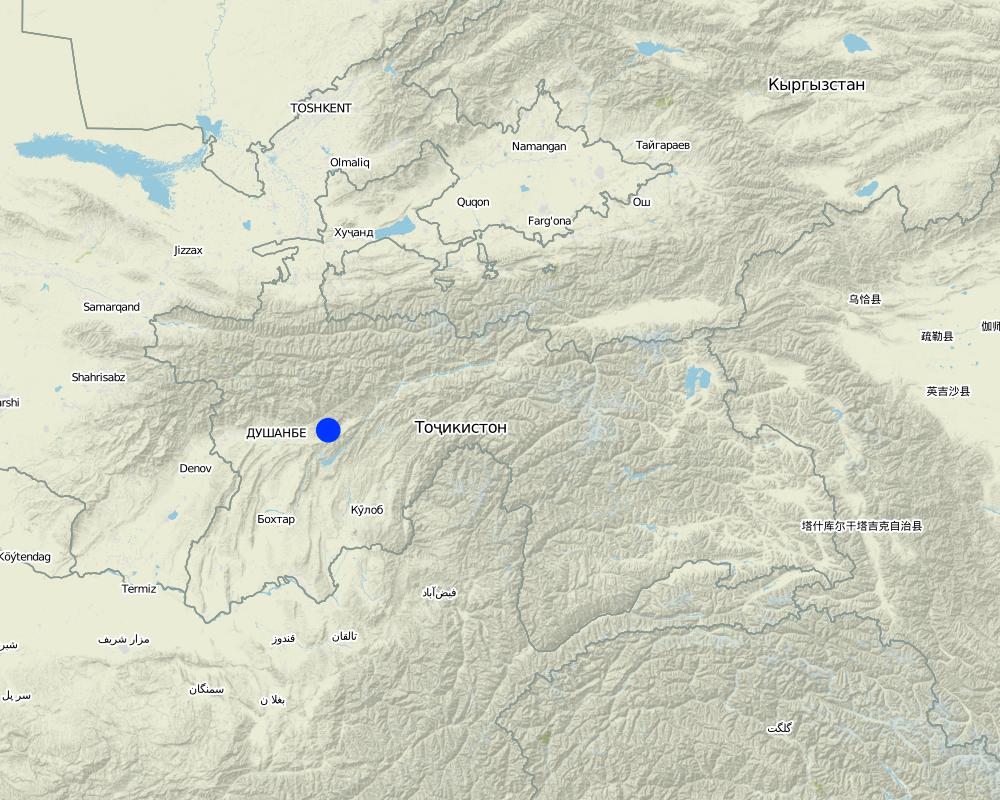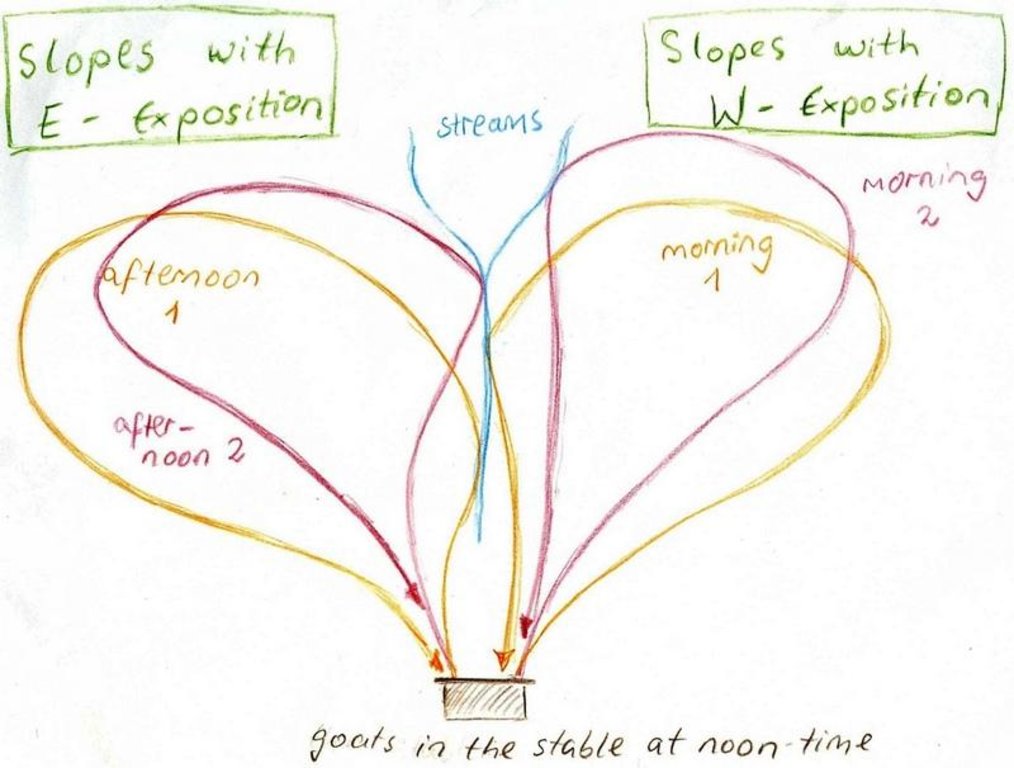Reduced livestock numbers [Tadjikistan]
- Création :
- Mise à jour :
- Compilateur : Christian Wirz
- Rédacteur : –
- Examinateurs : Alexandra Gavilano, David Streiff
technologies_1343 - Tadjikistan
Voir les sections
Développer tout Réduire tout1. Informations générales
1.2 Coordonnées des personnes-ressources et des institutions impliquées dans l'évaluation et la documentation de la Technologie
exploitant des terres:
Sahdullo
Karsang 1
Tadjikistan
Nom du ou des institutions qui ont facilité la documentation/ l'évaluation de la Technologie (si pertinent)
CDE Centre for Development and Environment (CDE Centre for Development and Environment) - SuisseNom du ou des institutions qui ont facilité la documentation/ l'évaluation de la Technologie (si pertinent)
NCCR North-South (NCCR North-South) - Kirghizistan1.3 Conditions relatives à l'utilisation par WOCAT des données documentées
Le compilateur et la(les) personne(s) ressource(s) acceptent les conditions relatives à l'utilisation par WOCAT des données documentées:
Oui
1.5 Référence au(x) Questionnaires sur les Approches de GDT (documentées au moyen de WOCAT)
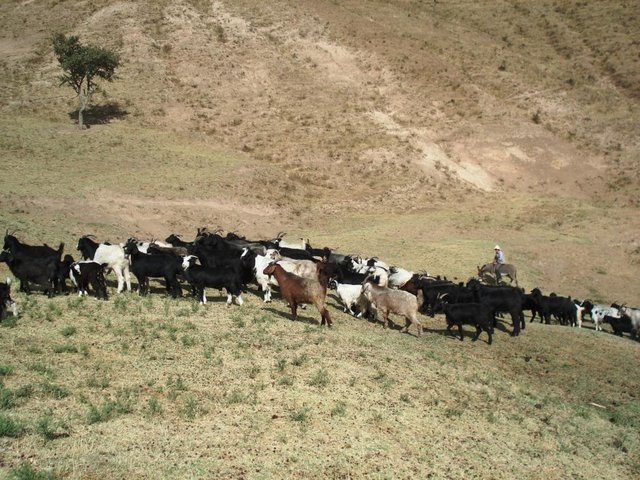
Family-based daily herding [Tadjikistan]
Private herding of 50 goats by the land user and his sons.
- Compilateur : Christian Wirz
2. Description de la Technologie de GDT
2.1 Courte description de la Technologie
Définition de la Technologie:
The grasslands are used as pastures by a reduced number of livestock belonging to an individual land user.
2.2 Description détaillée de la Technologie
Description:
The around 50 goats are brought to the pastures early in the morning and will be brought back to their stable from 9 a.m. to 5 p.m. After this, they will be accompanied to the pastures again. In the morning the west-exposed and in the afternoon the east-exposed pastures are visited. The same rotational scheme is applied over the whole year, which means that the same pastures are visited daily. The pastures are exclusively used by the land user fror more than the half of the year (from autumn to spring). In summer the pastures are also used by the village herd of the nearby village (Karsang). Herding is mostly the task of the land user's sons but sometimes he will accompany the animals by himself. Cows are let out on the pastures in the morning and come back in the evening by themselves.
Purpose of the Technology: The reason for west-facing grazing in the morning and east-facing in the evening is that grass is moist at these times of day. This is also why at noontime animals are not on the pastures. The animals are led slowly by the herder as to not tire them, to make them fatter and to avoid damages on vegetation.
Establishment / maintenance activities and inputs: No special pasture maintenance activities are undertaken.
Natural / human environment: The area is around one hour away from the village which actually controls the pastures (communal pastures). In addition snow lies longer in spring than further down. This means that the village herd only comes here from late spring to late summer, which decreases the pressure on the pastures. Together with the situation in a small depression that protects from high radiation in summer this contributes to the generally better pasture quality (greener, more grasses) compared with the village pastures in proximity to the villages. An important factor contributing to the generally good conservation state are the reduced livestock numbers. They are only reduced because the land user is close to these more distant pastures and the village is quite far away.
2.3 Photos de la Technologie
2.5 Pays/ région/ lieux où la Technologie a été appliquée et qui sont couverts par cette évaluation
Pays:
Tadjikistan
Région/ Etat/ Province:
Region of Republican Subordination
Autres spécifications du lieu:
Faizabad
Spécifiez la diffusion de la Technologie:
- répartie uniformément sur une zone
S'il n'existe pas d'informations exactes sur la superficie, indiquez les limites approximatives de la zone couverte:
- 0,1-1 km2
Commentaires:
Total area covered by the SLM Technology is 0.5 km2.
Map
×2.6 Date de mise en œuvre de la Technologie
Si l'année précise est inconnue, indiquez la date approximative: :
- il y a entre 10-50 ans
2.7 Introduction de la Technologie
Spécifiez comment la Technologie a été introduite: :
- grâce à l'innovation d'exploitants des terres
Commentaires (type de projet, etc.) :
The land user has rented land for the establishment of a self-sufficient agropastoral system after independence (early 1990ies). A part of the area was used as cropland when there was still a village (in the middle of the 20th century) whereas other parts of the land were also used as pastures.
3. Classification de la Technologie de GDT
3.1 Principal(aux) objectif(s) de la Technologie
- réduire, prévenir, restaurer les terres dégradées
3.2 Type(s) actuel(s) d'utilisation des terres, là où la Technologie est appliquée

Pâturages
Pâturage extensif:
- Ranching
Type d'animal:
- caprine
- cows
Espèces:
caprine
Nombre:
50
Commentaires:
Major land use problems (compiler’s opinion): Especially in the places where animals pass regularly and where they stay for longer times physical degradation of soils (compaction, crusting) together with the degradation of vegetation (cover and biomass) are major problems. In addition, low fertility is also a problem for vegetation growth.
Major land use problems (land users’ perception): Water erosion problems associated with wood chopping. And trees wood be very important for climate regulation.
Ranching: Goats, cows
3.4 Approvisionnement en eau
Approvisionnement en eau des terres sur lesquelles est appliquée la Technologie:
- pluvial
Commentaires:
Water supply: Also mixed rainfed - irrigated
3.5 Groupe de GDT auquel appartient la Technologie
- pastoralisme et gestion des pâturages
3.6 Mesures de GDT constituant la Technologie

modes de gestion
- M2: Changement du niveau de gestion / d'intensification
Commentaires:
Main measures: management measures
3.7 Principaux types de dégradation des terres traités par la Technologie

érosion hydrique des sols
- Wt: perte de la couche superficielle des sols (couche arable)/ érosion de surface

dégradation physique des sols
- Pk: scellage et encroûtement
- Pi: imperméabilisation des sols

dégradation biologique
- Bc: réduction de la couverture végétale
- Bs: baisse de la qualité et de la composition/ diversité des espèces
Commentaires:
Main type of degradation addressed: Wt: loss of topsoil / surface erosion
Secondary types of degradation addressed: Pk: sealing and crusting, Bc: reduction of vegetation cover, Bs: quality and species composition /diversity decline
Main causes of degradation: overgrazing (Big herds passing daily), other human induced causes (specify) (Inappropriate soils used for grazing), education, access to knowledge and support services, governance / institutional (Incapacity of government to implement soil conservation.)
3.8 Prévention, réduction de la dégradation ou réhabilitation des terres dégradées
Spécifiez l'objectif de la Technologie au regard de la dégradation des terres:
- prévenir la dégradation des terres
- réduire la dégradation des terres
Commentaires:
Main goals: prevention of land degradation, mitigation / reduction of land degradation
4. Spécifications techniques, activités, intrants et coûts de mise en œuvre
4.1 Dessin technique de la Technologie
Spécifications techniques (associées au dessin technique):
Daily rotation on pastures of the village Karsang.
Location: Above Naobad. Faizabad / Tajikistan
Date: 25.08.09
Technical knowledge required for land users: moderate (The land user developed his own rotational scheme.)
Technical knowledge required for herders (sons and grandsons of land user): low (They just need to apply the scheme.)
Main technical functions: increase in nutrient availability (supply, recycling,…)
Secondary technical functions: control of dispersed runoff: impede / retard, increase in organic matter, improvement of water quality, buffering / filtering water, promotion of vegetation species and varieties (quality, eg palatable fodder)
Change of land use practices / intensity level: Reduced livestock numbers
Auteur:
Christian Wirz, Switzerland
4.2 Informations générales sur le calcul des intrants et des coûts
autre/ monnaie nationale (précisez):
Somoni
Indiquez le taux de change des USD en devise locale, le cas échéant (p.ex. 1 USD = 79.9 réal brésilien): 1 USD = :
3,42
4.3 Activités de mise en place/ d'établissement
| Activité | Calendrier des activités (saisonnier) | |
|---|---|---|
| 1. | Buying livestock | Reduced livestock numbers |
4.4 Coûts et intrants nécessaires à la mise en place
| Spécifiez les intrants | Unité | Quantité | Coûts par unité | Coût total par intrant | % du coût supporté par les exploitants des terres | |
|---|---|---|---|---|---|---|
| Autre | Buying livestock | Goats | 50,0 | 87,7 | 4385,0 | 100,0 |
| Coût total de mise en place de la Technologie | 4385,0 | |||||
| Coût total de mise en place de la Technologie en dollars américains (USD) | 1282,16 | |||||
4.5 Activités d'entretien/ récurrentes
| Activité | Calendrier/ fréquence | |
|---|---|---|
| 1. | Herding | Daily |
| 2. | Giving salt to livestock | Twice per week |
| 3. | Fodder for livestock | In winter |
4.6 Coûts et intrants nécessaires aux activités d'entretien/ récurrentes (par an)
| Spécifiez les intrants | Unité | Quantité | Coûts par unité | Coût total par intrant | % du coût supporté par les exploitants des terres | |
|---|---|---|---|---|---|---|
| Main d'œuvre | Herding daily | days | 365,0 | |||
| Autre | Salt for animals | for one year | 1,0 | 12,0 | 12,0 | |
| Autre | Fooder for livestock | winter | 1,0 | |||
| Coût total d'entretien de la Technologie | 12,0 | |||||
| Coût total d'entretien de la Technologie en dollars américains (USD) | 3,51 | |||||
Commentaires:
The only effective costs mentioned by the land user is salt for animals. Other inputs - be it labour or winter forage - does not have to be paid, respectively bought.
4.7 Facteurs les plus importants affectant les coûts
Décrivez les facteurs les plus importants affectant les coûts :
Labour input is decisive: As long as work is done by family members costs are restricted on alimentation. If external labour is hired, wages have to be added.
5. Environnement naturel et humain
5.1 Climat
Précipitations annuelles
- < 250 mm
- 251-500 mm
- 501-750 mm
- 751-1000 mm
- 1001-1500 mm
- 1501-2000 mm
- 2001-3000 mm
- 3001-4000 mm
- > 4000 mm
Zone agro-climatique
- semi-aride
Thermal climate class: subtropics
5.2 Topographie
Pentes moyennes:
- plat (0-2 %)
- faible (3-5%)
- modéré (6-10%)
- onduleux (11-15%)
- vallonné (16-30%)
- raide (31-60%)
- très raide (>60%)
Reliefs:
- plateaux/ plaines
- crêtes
- flancs/ pentes de montagne
- flancs/ pentes de colline
- piémonts/ glacis (bas de pente)
- fonds de vallée/bas-fonds
Zones altitudinales:
- 0-100 m
- 101-500 m
- 501-1000 m
- 1001-1500 m
- 1501-2000 m
- 2001-2500 m
- 2501-3000 m
- 3001-4000 m
- > 4000 m
5.3 Sols
Profondeur moyenne du sol:
- très superficiel (0-20 cm)
- superficiel (21-50 cm)
- modérément profond (51-80 cm)
- profond (81-120 cm)
- très profond (>120 cm)
Texture du sol (de la couche arable):
- moyen (limoneux)
Matière organique de la couche arable:
- moyen (1-3%)
- faible (<1%)
Si disponible, joignez une description complète du sol ou précisez les informations disponibles, par ex., type de sol, pH/ acidité du sol, capacité d'échange cationique, azote, salinité, etc.
Soil fertility: Mainly medium, but also low
Soil water storage capacity: low - medium
5.4 Disponibilité et qualité de l'eau
Profondeur estimée de l’eau dans le sol:
> 50 m
Qualité de l’eau (non traitée):
eau potable
Commentaires et précisions supplémentaires sur la qualité et la quantité d'eau:
Ground water table: Mostly no groundwater, since very hilly.
Water quality (untreated): Good source water, since no diarrhae after drinking it.
5.5 Biodiversité
Diversité des espèces:
- élevé
Commentaires et précisions supplémentaires sur la biodiversité:
Many medical plants
5.6 Caractéristiques des exploitants des terres appliquant la Technologie
Revenus hors exploitation:
- moins de 10% de tous les revenus
Niveau relatif de richesse:
- riche
Individus ou groupes:
- individu/ ménage
Genre:
- hommes
Indiquez toute autre caractéristique pertinente des exploitants des terres:
Land users applying the Technology are mainly Leaders / privileged
Difference in the involvement of women and men: Women are implied in housework, whereas men are working as herders, because of traditions.
Population density: < 10 persons/km2
Annual population growth: 1% - 2%
Off-farm income specification: The land user only depends on the rented land, cultivated together with his two sons and their families.
5.7 Superficie moyenne des terres utilisées par les exploitants des terres appliquant la Technologie
- < 0,5 ha
- 0,5-1 ha
- 1-2 ha
- 2-5 ha
- 5-15 ha
- 15-50 ha
- 50-100 ha
- 100-500 ha
- 500-1 000 ha
- 1 000-10 000 ha
- > 10 000 ha
Cette superficie est-elle considérée comme de petite, moyenne ou grande dimension (en se référant au contexte local)?
- moyenne dimension
Commentaires:
The household has much more grazing land than average village households.
5.8 Propriété foncière, droits d’utilisation des terres et de l'eau
Propriété foncière:
- état
Droits d’utilisation des terres:
- accès libre (non organisé)
- communautaire (organisé)
Droits d’utilisation de l’eau:
- individuel
Commentaires:
Pastures are in theory used by village communities, but enforcement of rotational grazing in remote ares is difficult. These pastures are therefore something between communal and open access pastures. The water is used by the land user without any restrictions.
5.9 Accès aux services et aux infrastructures
santé:
- pauvre
- modéré
- bonne
éducation:
- pauvre
- modéré
- bonne
assistance technique:
- pauvre
- modéré
- bonne
emploi (par ex. hors exploitation):
- pauvre
- modéré
- bonne
marchés:
- pauvre
- modéré
- bonne
énergie:
- pauvre
- modéré
- bonne
routes et transports:
- pauvre
- modéré
- bonne
eau potable et assainissement:
- pauvre
- modéré
- bonne
services financiers:
- pauvre
- modéré
- bonne
6. Impacts et conclusions
6.1 Impacts sur site que la Technologie a montrés
Impacts socio-économiques
Production
qualité des fourrages
production animale
Revenus et coûts
revenus agricoles
Commentaires/ spécifiez:
His animals yield higher prices on the market than average livestock.
disparités économiques
Commentaires/ spécifiez:
The productive success of the land user lets him appear richer than the rest of the village.
Impacts socioculturels
sécurité alimentaire/ autosuffisance
Commentaires/ spécifiez:
Having a big herd on a big pasture area is a guarantee for better self-sufficiency.
apaisement des conflits
Commentaires/ spécifiez:
Especially in the establishment phase there was jealousy about the success, especially in fruit-production.
Livelihood and human well-being
Impacts écologiques
Sols
couverture du sol
Commentaires/ spécifiez:
Especially biomass is reduced by daily grazing.
perte en sol
encroûtement/ battance du sol
Biodiversité: végétale, animale
diversité végétale
Commentaires/ spécifiez:
Especially the proportion of grasses is higher compared with other village pastures
6.3 Exposition et sensibilité de la Technologie aux changements progressifs et aux évènements extrêmes/catastrophes liés au climat (telles que perçues par les exploitants des terres)
Changements climatiques progressifs
Changements climatiques progressifs
| Saison | Augmentation ou diminution | Comment la Technologie fait-elle face à cela? | |
|---|---|---|---|
| températures annuelles | augmente | pas bien |
Extrêmes climatiques (catastrophes)
Catastrophes climatiques
| Comment la Technologie fait-elle face à cela? | |
|---|---|
| sécheresse | pas bien |
6.4 Analyse coûts-bénéfices
Quels sont les bénéfices comparativement aux coûts de mise en place (du point de vue des exploitants des terres)?
Rentabilité à court terme:
très positive
Rentabilité à long terme:
très positive
Quels sont les bénéfices comparativement aux coûts d'entretien récurrents (du point de vue des exploitants des terres)?
Rentabilité à court terme:
très positive
Rentabilité à long terme:
positive
Commentaires:
On the long term benefits of animal husbandry might be slightly reduced due to damages on vegetation (and soils) by the own and by the animals of the village herd.
6.5 Adoption de la Technologie
- cas isolés/ expérimentaux
De tous ceux qui ont adopté la Technologie, combien d'entre eux l'ont fait spontanément, à savoir sans recevoir aucune incitation matérielle, ou aucune rémunération? :
- 91-100%
Commentaires:
Comments on acceptance with external material support: The only land user with this form of management known is the one interviewsd
100% of land user families have adopted the Technology without any external material support
There is no trend towards spontaneous adoption of the Technology
Comments on adoption trend: This form of management combines an exceptional personal spirit of innovation and financial means to lease land as to establish a self-sufficient system in the hills. It is also necessary to have a truck and / or car to transport goods to the market and to stay in touch with the rest of the family in the village, since it is too small to offer space to all the household members.
6.7 Points forts/ avantages/ possibilités de la Technologie
| Points forts/ avantages/ possibilités du point de vue de l'exploitant des terres |
|---|
|
Self-sufficiency is the main success for him. How can they be sustained / enhanced? It requires high labour inputs and motivation, which for the land user are necessary to have success in the post-USSR setting. |
| The animals yield a higher price because they are fatter than the other animals. |
| The geographic location is clearly an advantage, because the land user is far away from the negative impact of village herds. |
| Points forts/ avantages/ possibilités du point de vue du compilateur ou d'une autre personne ressource clé |
|---|
|
At the same time quite positive for soil and water conservation and productive in terms of meat and sold livestock. How can they be sustained / enhanced? If the land user could rent (parts of the) pastures the interest of planting trees as a measure of rehabilitation would increase. |
6.8 Faiblesses/ inconvénients/ risques de la Technologie et moyens de les surmonter
| Faiblesses/ inconvénients/ risques du point de vue de l’exploitant des terres | Comment peuvent-ils être surmontés? |
|---|---|
| Trees cannot recover because of constant grazing. | Only if the land user is sure that investments will profit him, that is if land tenure is clarified, will he invest into active conservation measures. |
| Faiblesses/ inconvénients/ risques du point de vue du compilateur ou d'une autre personne ressource clé | Comment peuvent-ils être surmontés? |
|---|---|
| Especially at the crossing-points of the land user's herd with the village herd degradation phenomena (trampling paths) are visible. | By an agreement between the village (land commitee) and the land user the land use could be reglemented clearer. |
| This form of land use is difficult to maintain for young people who want to participate in social life. And it is not sustainable because it does not permit allvillagers to practice such forms of herding that require much land. | The land user should be able to rent a part of the pastures (smaller than the actually grazed 50 ha) where he would be need to conserve soils and vegetation (for instance. by tree-planting or more sophisticated rotation. |
7. Références et liens
7.1 Méthodes/ sources d'information
Liens et modules
Développer tout Réduire toutLiens

Family-based daily herding [Tadjikistan]
Private herding of 50 goats by the land user and his sons.
- Compilateur : Christian Wirz
Modules
Aucun module trouvé


